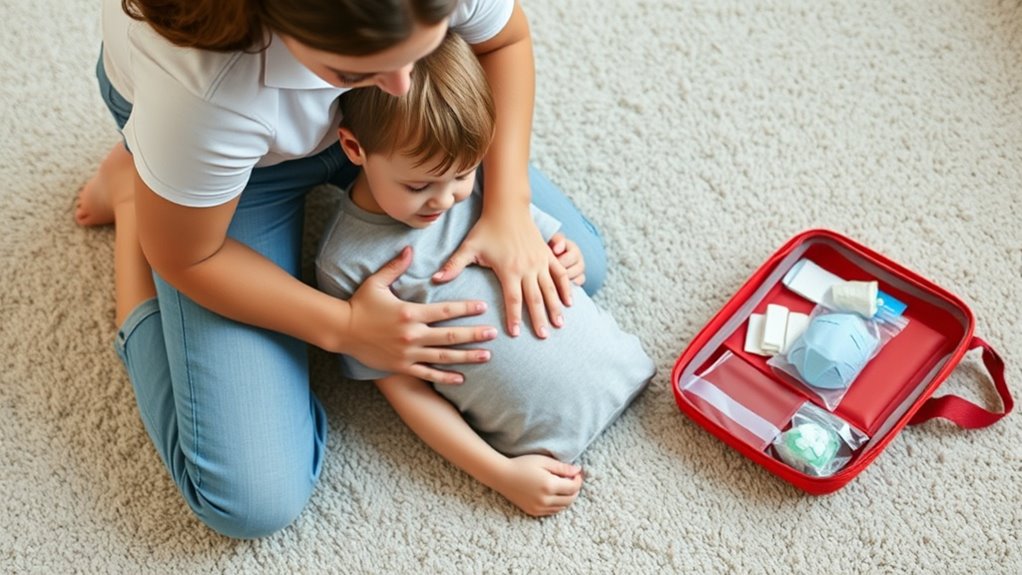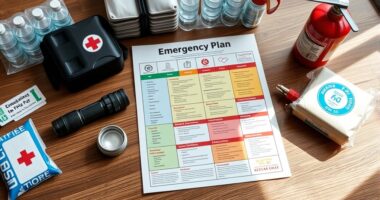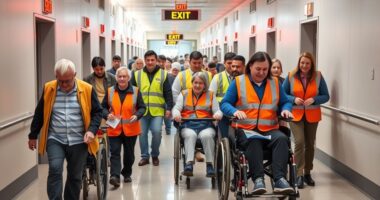To handle emergencies, stay calm and assess the situation quickly. Learn how to perform CPR with proper chest compressions and rescue breaths, and know when to call for help. If someone is choking, encourage coughing if possible, then administer abdominal thrusts to clear the airway. Keep your first aid kit ready and practice these skills regularly. Staying prepared and confident can make all the difference—keep going to discover more essential first aid techniques.
Key Takeaways
- Stay calm, assess the situation quickly, and ensure safety before providing aid.
- Recognize choking signs and perform abdominal thrusts or call emergency services if needed.
- Begin CPR promptly if the person is unresponsive, with proper chest compressions and rescue breaths.
- Follow the 30:2 compression-to-breath ratio and push hard and fast during CPR.
- Keep first aid skills updated through regular practice and ensure emergency contacts and supplies are accessible.

Have you ever wondered what to do if someone suddenly gets injured or feels unwell? Knowing basic first aid skills can make a significant difference in such moments. The first step is to stay calm and assess the situation quickly. Your actions should focus on injury prevention and emergency preparedness, which are the foundation of effective first aid. Being prepared means having a well-stocked first aid kit, knowing how to use it, and understanding how to respond to common emergencies like choking or cardiac arrest. Prevention is always better than cure, so taking steps to minimize hazards in your environment can reduce the risk of injuries. For example, securing loose rugs, storing sharp objects safely, and supervising children can prevent many accidents. When emergencies happen, your preparedness allows you to act swiftly and confidently, potentially saving lives.
In case of choking, your first priority is to determine if the person is indeed unable to breathe or speak. If they are coughing forcefully, encourage them to keep coughing, as this can often dislodge the object. If they cannot breathe, you need to act immediately. Call emergency services and then perform abdominal thrusts—commonly called the Heimlich maneuver. Stand behind the person, place your arms around their waist, make a fist with one hand, and position it just above the navel. Grasp your fist with your other hand and give quick, inward and upward thrusts. Repeat until the object is expelled or the person becomes unconscious. If they lose consciousness, carefully lower them to the ground and begin CPR if you’re trained to do so. CPR combines chest compressions and rescue breaths to maintain circulation and oxygen flow until professional help arrives. Additionally, understanding the different types of air purification technologies can be helpful in creating a healthier environment, especially for those with respiratory issues.
Understanding CPR basics is essential. To perform CPR correctly, place the heel of your hand on the center of the person’s chest, interlock your fingers, and keep your arms straight. Push hard and fast, at a rate of about 100 to 120 compressions per minute. After every 30 compressions, give two rescue breaths if you are trained and comfortable doing so. This cycle helps maintain critical circulation and oxygenation. Remember, your confidence and quick decision-making can make all the difference in an emergency. Emergency preparedness also involves knowing how and when to call for professional help, keeping your first aid kit accessible, and staying updated on first aid techniques. Practicing these skills regularly keeps you ready to respond effectively, ensuring you’re capable of handling sudden injuries or health issues with competence and composure.
Frequently Asked Questions
How Often Should CPR Training Be Renewed?
You should renew your CPR certification every two years to stay current with techniques and guidelines. Regular first aid refreshers are essential to maintain your skills and confidence in emergencies. Many organizations recommend taking refresher courses annually or as soon as your certification expires. Staying up-to-date guarantees you’re prepared to respond effectively, and it’s often a requirement for workplace safety standards or caregiving roles.
What Are Common Mistakes During Choking Rescue?
During a choking rescue, you might make common mistakes like applying too much force or performing ineffective rescue techniques. To prevent choking, focus on proper rescue techniques, such as delivering quick, firm back blows and abdominal thrusts. Avoid patting the person’s back gently or hesitating, which can worsen the situation. Staying calm and following correct rescue techniques helps make sure effective choking prevention and increases the chances of successfully clearing the airway.
Can Children Perform CPR on Adults?
Imagine a brave child stepping up, their tiny hands ready to help in an emergency. Yes, children can perform CPR on adults, but they should be supervised and trained in child CPR techniques for adult resuscitation. Their smaller size means compressions might be less forceful, so proper guidance is essential. This way, your child can confidently assist during a critical moment, potentially saving a life with the right skills.
How Do I Recognize a Stroke Quickly?
You recognize a stroke quickly by observing sudden weakness, numbness, or drooping on one side of the face, difficulty speaking or understanding, and sudden vision changes. You should act immediately if these stroke symptoms appear. A quick response is essential because timely treatment can reduce brain damage. Call emergency services right away, and stay with the person, keeping them comfortable and monitoring their condition until help arrives.
What Supplies Are Essential for a First Aid Kit?
Imagine a small, sturdy box filled with lifesaving tools—your first aid kit significance cannot be overstated. Essential supplies list includes adhesive bandages, antiseptic wipes, gauze pads, tweezers, scissors, gloves, and pain relievers. These items are vital for quick response during emergencies, helping you treat cuts, burns, or splinters efficiently. Keep it stocked and accessible, so you’re always ready to act when someone needs immediate care.
Conclusion
Remember, learning first aid is like holding a beacon of hope in your hands. Your knowledge can be the lighthouse guiding someone safely through the storm of an emergency. Every skill you acquire acts as an essential thread in the fabric of safety, ready to be woven into action when needed. By staying prepared, you become a symbol of reassurance—someone who can turn chaos into calm. Your readiness truly makes all the difference.









